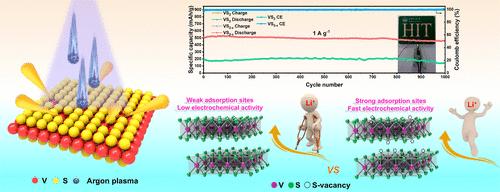用于高性能锂离子存储的VS2等离子体引入空位
IF 7.3
1区 化学
Q1 CHEMISTRY, MULTIDISCIPLINARY
引用次数: 0
摘要
VS2具有高导电性和大层间距等优点,是锂离子电池极具发展前景的电极材料。然而,有限的电化学活性和离子电导率限制了它的实际应用。本文首次通过Ar等离子体处理将硫空位(Vs)引入到VS2中,以提高其电导率,增加电化学活性位点数量,稳定吸附位点,促进Li+的快速扩散。与原始VS2相比,设计的富vs VS2具有更高的可逆容量和更好的循环稳定性(100次循环后0.1 A g-1为1137.5 mA h g-1, 1000次循环后1 A g-1为485.4 mA h g-1)(100次循环后395.9 mA h g-1, 1000次循环后204.4 mA h g-1)。此外,VS2-x //Li3V2(PO4)3/C全电池具有高容量和速率性能,有望用于高性能储能应用。此外,通过x射线衍射(XRD)分析,阐明了富vs的VS2在Li+存储中的插入和转化机制。密度泛函理论(DFT)计算表明,硫空位通过增加吸附位点数量和提高吸附能,有利于VS2对Li+的吸附。该研究为设计先进的锂离子电池负极材料提供了有价值的见解。本文章由计算机程序翻译,如有差异,请以英文原文为准。

Plasma-Introduced Vacancies in VS2 for High-Performance Lithium-Ion Storage
VS2 has attracted attention as a prospective electrode material for lithium-ion batteries (LIBs) due to its distinct advantages including high conductivity and large layer spacing. However, the limited electrochemical activity and ionic conductivity restrict its real applications. In this work, sulfur vacancies (Vs) were introduced into VS2 via Ar plasma treatment for the first time in order to enhance the electrical conductivity, increase the number of electrochemically active sites, stabilize adsorption sites, and facilitate rapid Li+ diffusion. The designed Vs-rich VS2 delivers higher reversible capacity and better cycling stability (1137.5 mA h g–1 at 0.1 A g–1 after 100 cycles, 485.4 mA h g–1 at 1 A g–1 after 1000 cycles) than those of pristine VS2 (395.9 mA h g–1 at 0.1 A g–1 after 100 cycles, 204.4 mA h g–1 at 1 A g–1 after 1000 cycles). Moreover, the VS2–x//Li3V2(PO4)3/C full-cells exhibit high capacity and rate performance, holding promise for high-performance energy storage applications. Additionally, the insertion and conversion mechanisms of Vs-rich VS2 for Li+ storage were elucidated by ex situ X-ray diffraction (XRD) analysis. The density-functional theory (DFT) calculations show that sulfur vacancies favor Li+ adsorption on VS2 by increasing the number of adsorption sites and improving the adsorption energy. This study offers valuable insights for designing advanced anode materials for LIBs.
求助全文
通过发布文献求助,成功后即可免费获取论文全文。
去求助
来源期刊

ACS Sustainable Chemistry & Engineering
CHEMISTRY, MULTIDISCIPLINARY-ENGINEERING, CHEMICAL
CiteScore
13.80
自引率
4.80%
发文量
1470
审稿时长
1.7 months
期刊介绍:
ACS Sustainable Chemistry & Engineering is a prestigious weekly peer-reviewed scientific journal published by the American Chemical Society. Dedicated to advancing the principles of green chemistry and green engineering, it covers a wide array of research topics including green chemistry, green engineering, biomass, alternative energy, and life cycle assessment.
The journal welcomes submissions in various formats, including Letters, Articles, Features, and Perspectives (Reviews), that address the challenges of sustainability in the chemical enterprise and contribute to the advancement of sustainable practices. Join us in shaping the future of sustainable chemistry and engineering.
 求助内容:
求助内容: 应助结果提醒方式:
应助结果提醒方式:


